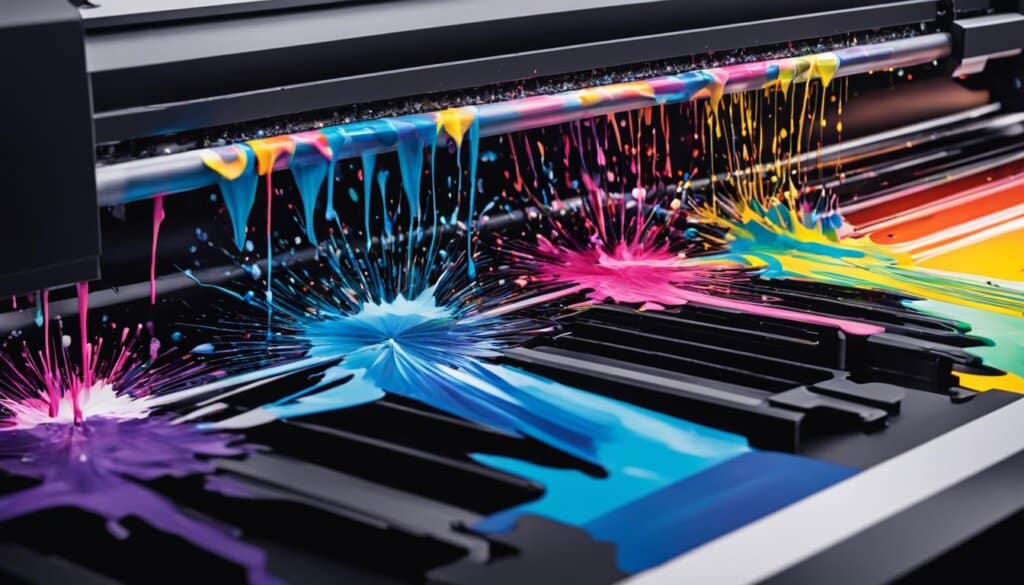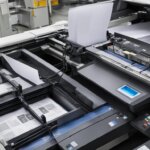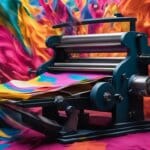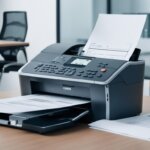Table of Contents
An inkjet printer is a computer peripheral that produces hard copies of text documents or photos by spraying droplets of ink onto paper. It is capable of producing color prints with high resolution, ranging from 1200 x 1440 dpi to 5760 x 1440 dpi.
There are different models available, some of which include additional features like scanners, photocopiers, and fax machines. Common brands include Epson XP, Canon Pixma, and HP DeskJet for home office printing, and Canon ImageCLASS and HP OfficeJet for business use.
In the following sections, we will delve deeper into how inkjet printers work, their pros and cons, and how to choose the right paper to maximize print quality.
How Do Inkjet Printers Work?
Inkjet printers are fascinating devices that use advanced technology to create high-quality prints. This section will explore the inner workings of inkjet printers, including the print head and ink cartridges.
The print head of an inkjet printer is a crucial component responsible for spraying tiny droplets of ink onto the paper as it moves through the printer. These droplets form characters and images, resulting in the final printout. The print head contains numerous small nozzles, each releasing ink precisely onto the paper to create the desired output.
To store and supply the ink, inkjet printers utilize ink cartridges. These cartridges typically consist of a black ink cartridge and a color inkjet cartridge containing cyan, magenta, and yellow ink. In some printers, there are separate cartridges for each primary pigment, along with a black ink cartridge.
The ink cartridges play a vital role in ensuring consistent and accurate printing. When the ink in the cartridges runs low, the printer will prompt the user to replace them. The number of pages a printer can produce before requiring a cartridge replacement can vary, ranging from 100 to several hundred pages, depending on the printer model and cartridge capacity.
The image above illustrates the intricate workings of an inkjet printer, showcasing the print head and ink cartridges in action.
Inkjet Printer Technology at Work
Understanding how inkjet printers work begins with the print head. The print head contains tiny nozzles that release precise droplets of ink onto the paper. These nozzles are heated, causing the ink to vaporize and form droplets that are propelled onto the paper. The droplets of ink combine to create characters, graphics, and images, resulting in a high-quality printout.
The ink cartridges are responsible for storing and supplying the ink to the print head. The ink in the cartridges is formulated to flow smoothly through the nozzles and onto the paper. The cartridges need to be properly aligned with the print head to ensure accurate placement of the ink droplets.
Inkjet printers offer impressive print quality, with the ability to reproduce intricate details, vibrant colors, and sharp text. The technology behind inkjet printers has evolved over the years, resulting in improved print speeds, higher resolutions, and enhanced color accuracy.
A Closer Look: The Print Head
The print head is a critical component of an inkjet printer, responsible for accurately placing the ink droplets onto the paper. It consists of tiny nozzles that spray the ink onto the paper, creating the desired output. The number of nozzles can vary depending on the printer model and technology.
The print head moves back and forth across the paper, depositing the ink droplets in a precise pattern to form characters, graphics, and images. The droplets are released at high speed, ensuring seamless and continuous printing.
| Advantages | Disadvantages |
|---|---|
| Produces high-quality prints | Ink can be expensive to replace |
| Capable of reproducing vibrant colors | Prints may take longer to dry |
| Offers precise placement of ink droplets | Not suitable for high-volume printing |
The table above highlights the advantages and disadvantages of using inkjet printers, helping users make informed decisions about their printing needs.
Pros and Cons of Using Inkjet Printers
When it comes to printing, inkjet printers offer several advantages that make them popular choices for personal and professional use. However, they also have some drawbacks that users should consider. In this section, we will explore the pros and cons of using inkjet printers.
Advantages of Inkjet Printers
Affordability: Inkjet printers are known for their affordability, with even the cheapest models being satisfactory for personal computer users. They are an excellent choice for individuals on a budget who need to print documents or occasional photos.
High-Quality Prints: High-end inkjet printers can produce exceptional printouts that rival professionally produced photographs. With resolutions ranging from 1200 x 1440 dpi to 5760 x 1440 dpi, inkjet printers ensure sharp details and vibrant colors, making them ideal for graphic designers, photographers, and artists.
Portability: Inkjet printers are lightweight and compact, making them easy to transport. Whether you need to print on the go or move your printer around the office or home, inkjet printers offer the convenience of being portable.
Disadvantages of Inkjet Printers
Drying Time: One downside to using an inkjet printer is that the ink requires time to dry, especially when printing large regions of solid black or color. This can lead to smudging or smearing if the prints are not handled carefully.
Not Suitable for High-Volume Printing: Inkjet printers are not designed for high-volume print jobs. Their ink cartridges have limited capacity, resulting in frequent replacements and interruptions for refilling. This can be impractical for offices or businesses that require constant printing.
Operating Costs: Over time, inkjet printers can be expensive to operate compared to laser printers. The cost of ink cartridges can add up, particularly if you print frequently or in large quantities. Users should consider the long-term operating costs before investing in an inkjet printer.
“Inkjet printers offer affordability, high-quality prints, and portability. However, users need to be aware of the drying time, limited capacity for high-volume printing, and potential operating costs.”
| Advantages | Disadvantages |
|---|---|
| Affordability | Drying Time |
| High-Quality Prints | Not Suitable for High-Volume Printing |
| Portability | Operating Costs |
Overall, inkjet printers offer a range of benefits, such as affordability, high-quality prints, and portability. However, users need to be aware of factors like drying time, limited capacity for high-volume printing, and potential operating costs. Understanding these pros and cons can help individuals and businesses make informed decisions when choosing an inkjet printer.

Choosing the Right Paper for Inkjet Printers
Inkjet printers are renowned for their ability to produce high-quality prints, but did you know that the paper you use plays a crucial role in the final result? When it comes to inkjet printers, using the right paper type is essential to achieve the best possible image quality.
Non-porous paper is a must for inkjet printers. Bond paper containing cotton or other fibers may cause the ink to bleed or smudge, resulting in lower-quality images. To ensure crisp and vibrant prints, it is highly recommended to use specific photo paper designed specifically for inkjet printing. This type of paper is heavier, brighter, and may be slightly more expensive compared to paper used with laser printers or photocopiers.
The quality of the paper is an important factor to consider when printing with an inkjet printer. Brightness and absorption properties significantly influence the final image quality. Opting for a paper with a higher brightness level will ensure that your prints have vivid colors and sharp details. Additionally, the absorption properties of the paper determine how quickly the ink is absorbed and dried, preventing smudging or smearing.
So, when choosing paper for your inkjet printer, remember to select non-porous paper, especially when printing photos. Investing in high-quality inkjet photo paper will help you achieve stunning results with vibrant colors and sharp details. By considering the brightness and absorption properties of the paper, you can ensure optimal performance from your inkjet printer and produce professional-quality prints every time.
FAQ
What is an inkjet printer?
An inkjet printer is a computer peripheral that produces hard copies of text documents or photos by spraying droplets of ink onto paper.
How do inkjet printers work?
Inkjet printers work by using a print head with tiny nozzles that spray ink onto paper as it moves past. The ink droplets form characters and images to create the printout.
What types of ink cartridges are used in inkjet printers?
Ink is stored in ink cartridges, which typically consist of a black ink cartridge and a color inkjet cartridge containing cyan, magenta, and yellow ink. Some printers use separate cartridges for each primary pigment, along with a black ink cartridge.
How many pages can an inkjet printer produce before ink cartridges need to be replaced?
The number of pages a printer can produce before the ink cartridges need to be replaced varies, ranging from 100 to several hundred pages.
What are the advantages of using inkjet printers?
One advantage of inkjet printers is their affordability, with even the cheapest models being satisfactory for personal computer users. High-end inkjet printers can produce high-quality prints that rival professionally produced photographs. Inkjet printers are also lightweight and compact, making them easy to transport.
What are the downsides of using inkjet printers?
Inkjet printers require time for the ink to dry, particularly when printing large regions of solid black or color ink. They are not designed for high-volume print jobs and can be expensive to operate over time compared to laser printers.
What types of paper should be used with inkjet printers?
Inkjet printers require using non-porous paper to ensure high-quality prints. Bond paper containing cotton or other fibers can cause the ink to bleed or smudge, resulting in lower-quality images. For inkjet photo prints, specific photo paper designed for inkjet printing is recommended.







